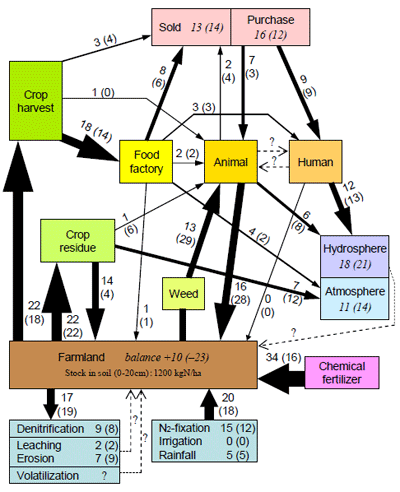Change in nitrogen cycle related to agricultural activity from 1990 to 2000 in Khon Kaen Province, Thailand
Description
With the development of the Thai economy from 1990 to 2000, the agricultural situation changed, showing increased chemical fertilizer application rates and lower numbers of buffalo being raised, resulting in a shortage of animal manure for farmers. To clarify the subsequent changes in the nitrogen cycle, we estimated the nitrogen cycle in Khon Kaen province in Northeast Thailand in 1990-92 and 2000-02.
The nitrogen cycle in Khon Kaen province was estimated using Thai agricultural statistics, study reports of food consumption and human excreta discharge, animal feed consumption and animal excrement production, survey data on the utilization of crop residues, human excreta, garbage, animal excrement and food factory (rice mill, sugar mill, cassava chips and starch) waste, measurement data of crop residue production and nitrogen content of crop residues, animal excrement and food factory waste, and journal articles on N2 fixation and nitrogen losses from farmland.
Nitrogen cycle related to agriculture activity in 1990-92 and 2000-02 in Khon Kaen province is shown in Fig. 1. Chemical fertilizer application doubled from 16 kg N ha–1 year–1 in 1990-92 to 34 kg N ha–1 year–1 in 2000-02, caused by an increase in the chemical fertilizer application rate to rice and cassava cultivation by farmers to the recommended rate. Sugarcane was already having chemical fertilizer applied at the recommend rate in 1990. Animal manure input to farmland decreased 40%, from 28 kg N ha–1 year–1 in 1990-92 to 16 kg N ha–1 year–1 in 2000-02, because animal excrement production fell due to the sharp decrease in numbers of buffalo being raised, although the number of cattle, pigs and poultry increased. The amount of crop residues returned to farmland more than doubled, from 4 kg N ha–1 year–1 in 1990-92 to 14 kg N ha–1 year–1 in 2000-02, due to sugarcane residue (leaves and tops) production increasing as a result of a more than doubling of sugarcane area cultivated, and because the rate of return of sugarcane residue to farmland increased from 40% to 54%. The nitrogen balance in farmland changed from a negative –23 in 1990-92 to a positive value of +10 kg N ha–1 year–1 in 2000-02, caused by an increase in the chemical fertilizer application rate to +18 kg N ha–1 year–1 and crop residue input of +10 kg N ha–1 year–1 in spite of a –12 kg N ha–1 year–1 decrease in animal manure input. Nitrogen supply to farmland thus changed mainly to chemical fertilizer, which threatens the sustainability of crop production due to degradation of soil organic matter. Nitrogen loaded from humans to the hydrosphere risks polluting underground water in populated areas. For sustaining crop production and environmental conservation in Khon Kaen province, effective utilization of crop residues is needed, such as the use of sugarcane residue as mulch and rice straw as compost, improvements in animal raising systems to increase manure production, and the development of treatment and effective use of human excreta.
Figure, table
-
Fig. 1 Nitrogen cycle-related to agriculture activity in 1990-92 and 2000-02 in Khon Kaen Province, Thailand (kg N ha-1 year-1).
Values outside parentheses indicate nitrogen flow in 2000-02, and values inside parentheses indicate nitrogen flow in 1990-92. Values in italics are calculated by subtracting output from input.
- Affiliation
-
Japan International Research Center for Agricultural Sciences Crop Production and Environment Division
- Term of research
-
FY2005
- Responsible researcher
-
MATSUMOTO Naruo ( Crop Production and Environment Division )
PAISANCHAROEN Kobkiet ( Khon Kaen Field Crop Research Center )
- ほか
- Japanese PDF
-
2005_seikajouhou_A4_ja_Part8.pdf481.53 KB

